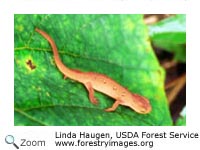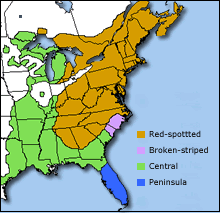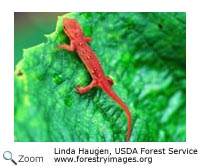Eastern Newt - Notophthalmus viridescens |
||||||||||
Description In the second stage, the eastern newt lives on land and is called a red eft. Red efts can grow to be about three inches in length and can live on land for 3-4 years before they change into adult eastern newts. The red eft has rough red to reddish-orange skin and a rounded tail. The adult eastern newt is yellowish-brown, olive green, or brown on its uppersides, and it has a yellow belly with black spots. Its tail is more flattened than the tail of the red eft. Adult eastern newts are 2½-5½ inches in length. There are four subspecies of the eastern newt. The Red-spotted newt, the broken-striped newt, the central newt, and the peninsula newt. The red-spotted newt has black-bordered orange-red spots when it is a red eft. The broken-striped newt is reddish-brown and has stripes on its back in the red eft stage. The central newt usually has no spots or stripes in the red eft stage. Range |
HabitatThe adult eastern newt lives in ponds, lakes, streams, and marshes. The red eft is found in moist deciduous and coniferous forests. DietEastern newt larvae eat aquatic insects and crustaceans. Red efts eat insects, especially springtails. They also eat snails. The adult eastern newt eats a wide variety of insects. It also eats worms, small crustaceans, and amphibian and fish eggs. Life Cycle
BehaviorThe red eft's bright red color is advertising coloration. It serves as a warning to predators that the red eft produces a poisonous toxin that can kill small predators like mice. The eastern newt produces toxins in all three stages, but the toxin is at its strongest during the red eft stage. |
|||||||||


 The eastern newt is found from Nova Scotia in Canada south to Florida and west to Ontario and Texas. The red-spotted newt is found from Nova Scotia south to Georgia. The broken-striped newt is found in coastal North and South Carolina. The central newt is found from Ontario, Canada south to the Gulf of Mexico. The peninsula newt is found in Florida.
The red-spotted newt is the subspecies of the eastern newt found throughout New Hampshire.
The eastern newt is found from Nova Scotia in Canada south to Florida and west to Ontario and Texas. The red-spotted newt is found from Nova Scotia south to Georgia. The broken-striped newt is found in coastal North and South Carolina. The central newt is found from Ontario, Canada south to the Gulf of Mexico. The peninsula newt is found in Florida.
The red-spotted newt is the subspecies of the eastern newt found throughout New Hampshire.